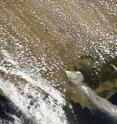Unusual weather events identified during the Black Saturday bushfires
Research has revealed that the extremely hot, dry and windy conditions on Black Saturday in the Australian state of Victoria combined with structures in the atmosphere called 'horizontal convective rolls' -- similar to streamers of wind flowing through the air -- which likely affected fire behaviour. The study is the first of its kind to produce such detailed, high-resolution simulations of weather patterns on the day and provides insights for future fire management and warning systems.
The work was led by Dr Todd Lane and Ms Chermelle Engel from The University of Melbourne with Prof Michael Reeder (Monash University) and Dr Michael Rezny (ARC Centre of Excellence for Climate System Science).
The team examined meteorological conditions across Victoria on 7 February, 2009. The analysis used a very high-resolution weather forecasting model, which represented the airflow over the entire state on 400 metre weather grids, which are about ten times smaller than the grids used in operational weather forecasting. Weather conditions observed on the day were used to validate the model.
"Fire fighters reported extraordinary behaviour from the Black Saturday bushfires. We wanted to understand what weather characteristics produce these extreme conditions to aid future fire control efforts," said Dr Lane from the School of Earth Sciences at The University of Melbourne.
"We found that weather events at a horizontal scale of about 10 kilometres introduced variability in the wind, temperature and humidity conditions. These smaller events combined to produce significant variability in fire danger across much of Victoria."
"Similar wind patterns have been observed previously on hot days, but the convective rolls on Black Saturday were unusual as the high temperatures meant they were stronger and spaced wider apart. The rolls create bands of fast and slow wind around 5-10 kilometres apart, causing variations in fire danger. Fire spread is related to wind speed and the rolls might have caused fires to behave differently over a relatively small distance," added Dr Lane.
On the day a strong late-afternoon cool change and a second weaker late-evening cool change altered conditions dramatically as it moved across the state.
Professor Reeder said one of the most astonishing results from the study was that after sunset the cold front generated a wave (technically called an undular bore).
"This wave propagated ahead of the front and appeared to have reinvigorated the fire around Beechworth. Although we believe that this kind of behaviour is common, this is the first time it has been documented.."
"With improved computing power in the future, this kind of analysis should be useful for operational forecasting on days of fire danger, providing a better guide for public warning systems and fire fighting resources," said Ms Engel.
The work was funded by the Australian Research Council and is published online in the Quarterly Journal of the Royal Meteorological Society.
Source: University of Melbourne
Other sources
- Strange Weather Helped Fuel Australia's 'Black Saturday' Firesfrom Live ScienceFri, 10 Aug 2012, 21:00:20 UTC
- Unusual weather events identified during the Black Saturday bushfiresfrom Science DailyWed, 8 Aug 2012, 17:06:41 UTC
- Unusual weather events identified during the Black Saturday bushfiresfrom PhysorgWed, 8 Aug 2012, 14:01:02 UTC
